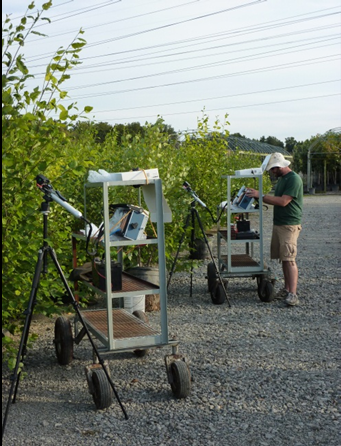You are here
Results
 Duel gas exchange systems are used to collect the seasonal change in physiological (model input) parameters for the ten tree species being studied at Willoway.
Duel gas exchange systems are used to collect the seasonal change in physiological (model input) parameters for the ten tree species being studied at Willoway.One objective of this study was to develop an understanding of substrate moisture distribution patterns within container-grown plant material. By focusing on ten of the commonly cultivated tree species at Willoway, we are identifying any differences in water use between these species, to more precisely apply irrigation water.
Results from 2010 show that process model remote application has decreased water application by > 300% and warrants species specific irrigation (~47% variation betweenTilia and Acer sp. water needs). Growth measurements between control and trees irrigated using the model estimates indicate no negative impact on production.
We think that the optimum number and arrangement of substrate moisture sensors probably varies among species and changes over time. After establishing the spatial and temporal variation, we will determine the minimum number and arrangement of substrate moisture sensors for each of the ten species we are studying.
Over the course of the growing season, we also measured variables for a species specific transpiration model to include: gas exchange (pictured at right), leaf spectral characteristics, wind speed attenuation, growth attributes, and remote sensing characteristics on a monthly basis. The data from these measurements are currently being used to parameterize a 3D canopy transpiration model (MAESTRA) for an entire growing season. During 2011, this information will be used to provide estimates of water usage per species and remotely schedule irrigation on a species basis.
